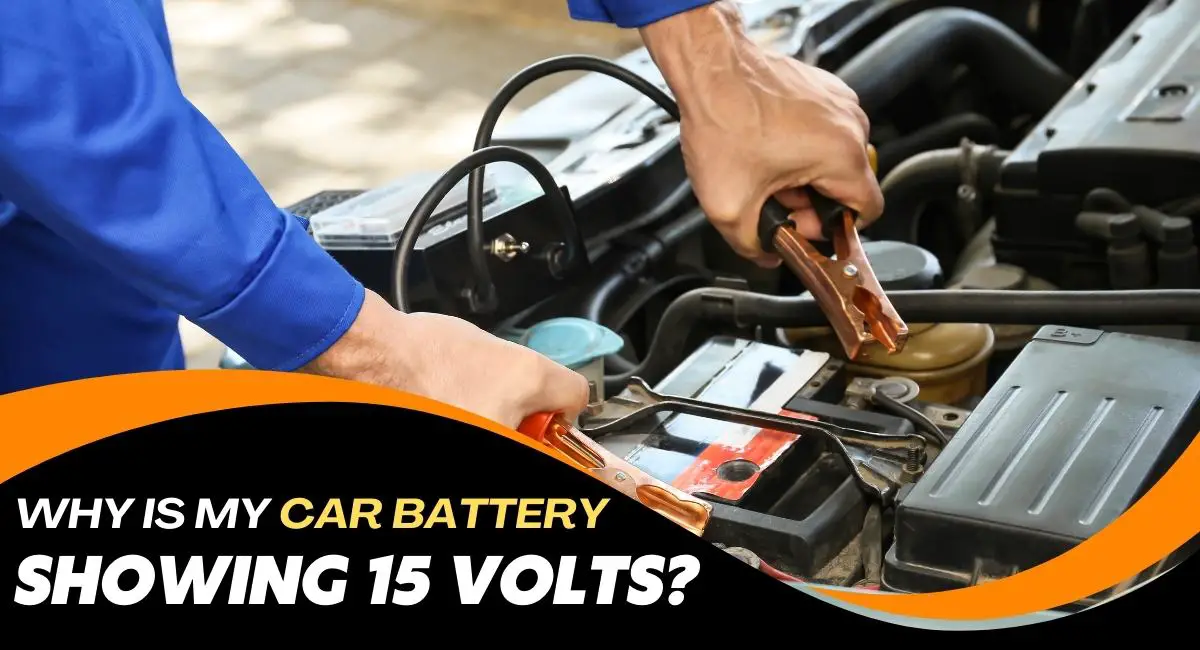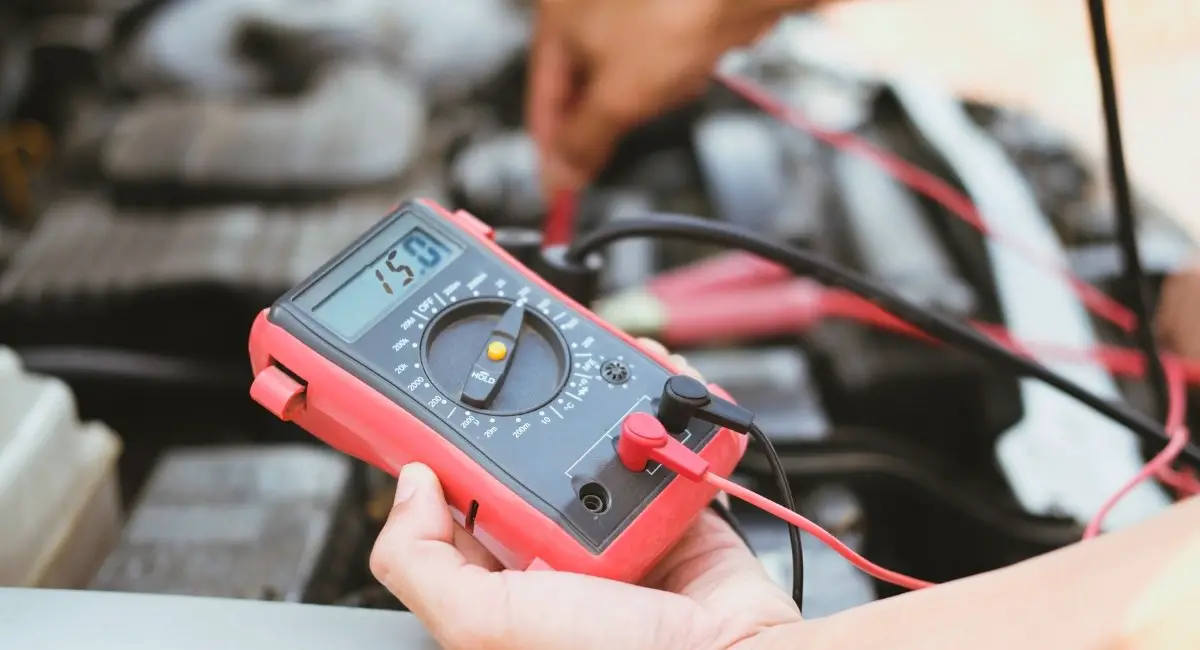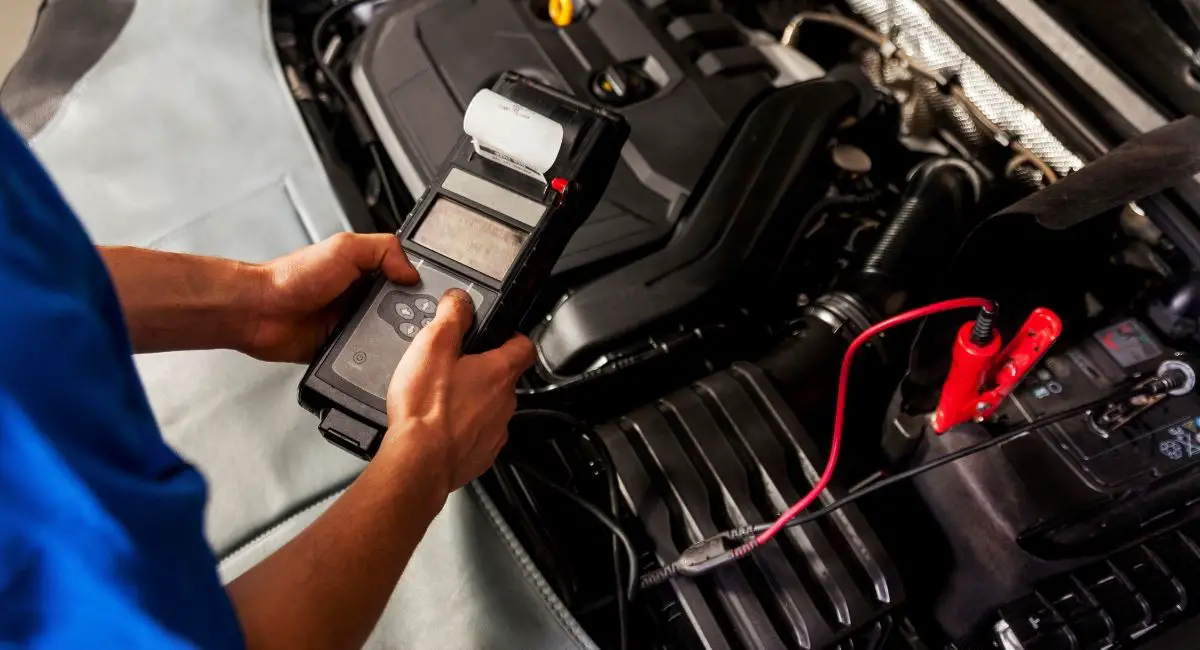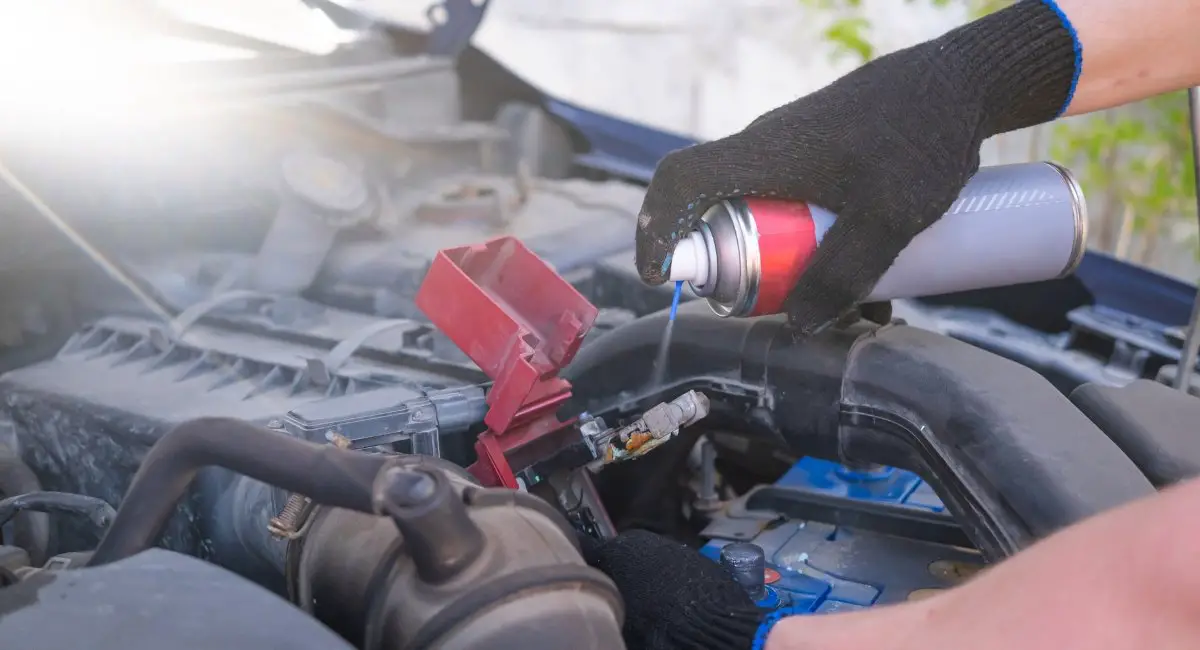You turn the key in the ignition, expecting the usual hum of your engine waking up, but instead, you get a surprising sight on your car’s dashboard. The battery reading is showing 15 volts. Panic sets in as you wonder, is this a cause for concern?
The battery is considered within normal parameters when the voltmeter indicates a reading between 12.4 and 14.4 volts. However, if the battery registers a voltage exceeding 15 volts or falling below 13 volts, it suggests a potential issue with the alternator. It could mean the alternator is overcharging the battery or needs to supply sufficient charge.
This article explains the car battery voltage, explores why a car battery reads 15 volts, guides you through the steps to diagnose and resolve this unexpected issue, and discusses what to do when the voltage goes below 13V.
Understanding Car Battery Voltage
Let’s start by unraveling the basics. The battery is a vital part of your car’s functioning. Did you know that apart from starting the engine, the battery supplies electrical energy to operate various vehicle systems? The systems include lights, opening and closing the windows, securing the doors, or maintaining the music playback when the engine is not running or during periods of high demand.
However, your car’s battery voltage is like a heartbeat, indicating its overall health. A healthy battery should typically show several readings. When the engine runs, an ideal voltage falls between 13.7 to 14.7V. When the engine is off, the voltage should read 12.6 volts. If the battery has no full charge, it decreases to 12.4V at 75%, 12V at 25%, and down to 11.9V when wholly discharged.
Various factors such as temperature, age, and usage can influence this range, but what happens when your car battery reading displays a surprising 15 volts? Is it the battery or alternator issue?

Reasons for Car Battery Showing 15 Volts
If a car battery consistently shows 15 volts, it could indicate several potential problems:
Overcharging
Imagine your car battery as a delicate flower – it needs just the right amount of sunlight.
Similarly, a car battery requires the correct voltage to function optimally. Overcharging occurs when the charging system supplies more voltage than necessary. It can lead to a surge in voltage, and your battery may display an alarming 15 volts.
Overcharging doesn’t just affect the voltage reading; it can also lead to increased heat, potentially damaging the battery over time. The excess voltage causes the electrolyte inside the battery to overheat, accelerating the aging process and reducing the battery’s overall lifespan.
Faulty Voltage Regulator
The voltage regulator plays a crucial role in maintaining a balanced power supply to the battery. When this component malfunctions, it can allow excess voltage to flow, resulting in a higher-than-normal reading on your battery.
Think of the voltage regulator as an orchestra conductor, ensuring each section (or component) gets the right power. When this conductor goes awry, it disrupts the harmony of your car’s electrical system, leading to potential issues like a 15-volt reading.
Issues with the Charging System
The charging system, comprising the alternator and diodes, is like the backbone of your car’s electrical system. If either of these components develops problems, it can disrupt the delicate voltage balance, causing spikes that may lead to a 15-volt reading.
The alternator, responsible for generating electrical power, may experience worn-out brushes, a faulty voltage regulator, or even a damaged rotor.
On the other hand, malfunctioning diodes can create a one-way street for electrical flow, causing irregularities in voltage output.
Is 15 Volts Too High for a Car Battery?
Now that we’ve identified potential culprits let’s address the burning question – is 15 volts too high for a car battery? In short, yes. The standard voltage range is well below this figure, typically between 12.4 to 14.4 volts. Elevated voltage can pose risks, affecting your battery’s short-term performance and long-term health.
Impact on Battery Health
Short-term effects of high voltage include an increased risk of overcharging, which can lead to excessive heat and potential damage to the battery. Long-term consequences may manifest as reduced overall performance and interfere with how long a battery lasts.
Testing and Confirming High Voltage
The best way to confirm whether your car battery shows 15 volts is to use a multimeter. This handy tool permits you to measure the voltage accurately. Follow these steps:
Set Up the Multimeter
Start by adjusting the multimeter to the DC voltage setting. Most car batteries operate on a 12-volt system, so ensure your multimeter you set to an appropriate range, often around 20 volts.
Connect the Multimeter
Attach the multimeter to the battery terminals, connecting the red, which is positive, leads to the positive terminal, and the negative (black) leads to the negative terminal.
Read the Voltage
Once connected, read the voltage displayed on the multimeter. You’ve confirmed the elevated voltage if it reads 15 volts or higher.

Diagnosing and Resolving the Issue
Now that you’ve confirmed the issue, it’s time to play detective and uncover the root cause.
Visual Examination
Commence with visually inspecting the battery and components of the charging system. Check for indications of corrosion on the battery terminals, damaged wiring, or loose connections. Resolve any observable issues before moving forward.
Corrosion on battery terminals can disrupt the flow of electricity, leading to irregular voltage readings. If you notice a powdery substance on the terminals, it’s a clear sign of oxidation. Clean the terminals using a mixture of baking soda and water, ensuring a secure and unimpeded electrical connection.
Professional Help
If you need to be more comfortable diagnosing the problem, seek professional help. A trained mechanic can conduct a thorough assessment, identifying the specific issue and recommending appropriate solutions.
Professional help is especially crucial when dealing with internal components like the alternator or voltage regulator. These intricate parts may require specialized tools and expertise to diagnose and repair accurately.
Possible Solutions to Reduce Voltage
Once you’ve identified the cause, consider the following solutions:
Adjusting the Voltage Regulator
If the issue lies with the voltage regulator, adjusting it to restore the proper voltage balance may be possible. A qualified professional should carry out this adjustment. Still, you can watch the video to know what to do by yourself to adjust the regulator.
The voltage regulator is like the thermostat of your car’s electrical system, ensuring the battery receives the right amount of charge. A professional can recalibrate the regulator to prevent overcharging and bring the voltage back to a normal range.
Repairing or Replacing Faulty Components
For issues with the charging system, such as a malfunctioning alternator or diode, repair or replacement may be necessary. Addressing these components can prevent further damage and return the voltage to normal.
The alternator converts mechanical energy into electrical power and can experience wear and tear over time. Replace worn-out brushes inside the alternator or the faulty voltage regulator. Repairing or replacing these components is crucial to restore the proper charging function.
What Should Be Done if the Voltage Reading Falls Below 13 Volts?
Today, your voltage reading is below 13 when the engine is running. Is this a point of concern?
A voltage reading of 13 volts for a vehicle’s battery, especially when the engine is not running, is generally not considered very low or dangerous.
As mentioned, a fully charged and healthy car battery at rest typically measures around 12.6 to 12.8 volts. A reading of 13 volts may suggest the battery has a moderate charge. If the voltage consistently drops below 13 volts in your car battery, it may signal a potential problem with the battery or the charging system. However, here are some steps you can take:
- Make sure the battery terminals are free from corrosion, securely tightened, and kept clean. Poor connections can lead to a drop in voltage.
- An alternator that is not functioning may fail to charge the battery correctly. Check the alternator for wear or damage, and guarantee the drive belt is in perfect condition.
- Use a multimeter to assess the battery’s voltage when the vehicle is off (around 12 volts) and running (between 13.5 and 14.7 volts). The battery may need replacement if the voltage is significantly lower than expected.
- If the battery is low on charge, you can use a charger to return it to the proper voltage level. Follow the manufacturer’s instructions for the specific charger you are using.
- If you cannot identify or resolve the issue, take your vehicle to a professional mechanic or an auto repair shop. They can deeply analyze the charging system and the battery to pinpoint and fix the problem.
Remember that a healthy car battery should generally read around 12.6 volts when the engine is off and can reach up to around 14 volts when the engine is running. If you are unsure or uncomfortable performing these checks, seeking assistance from a qualified mechanic is the safest option.
Preventive Measures for Car Battery Reading 15 Volts
To avoid finding yourself in a situation where your car battery is showing 15 volts, incorporate these preventive measures into your routine maintenance:

Regular Battery Health Checks
Perform routine checks on your battery’s health, including visual inspections of the terminals and regular voltage tests. You can do this every 6000 miles or basically after every 6 months. When you identify the issues early, you can prevent them from escalating.
Regular battery health checks are akin to routine doctor visits – they allow you to catch potential issues before they become significant problems. By monitoring your battery’s voltage and addressing any irregularities promptly, you can extend its lifespan and ensure reliable performance.
Checking and Cleaning Battery Terminals
Corrosion on battery terminals can hinder proper electrical flow. Regularly clean the terminals using a mixture of baking soda and water to prevent buildup.
Think of battery terminals as the gateway for electrical energy. Keeping them clean ensures a smooth power flow between the battery and the rest of the electrical system. Regular cleaning also minimizes the risk of corrosion-related voltage irregularities.

Monitoring the Charging System
Monitor the charging system components, especially the alternator and diodes.
Unusual noises or warning lights may indicate a problem that requires attention.
Listening to your car is a skill that can save you from potential headaches. If you notice strange noises from the alternator or see warning lights on your dashboard, don’t ignore them. Addressing issues can prevent voltage irregularities and ensure the overall health of your charging system.
Conclusion
A 15-volt reading is a red flag demanding attention in car batteries. You can safeguard your battery’s health by understanding the reasons behind such a reading, testing and confirming the voltage, and promptly diagnosing and resolving the issue. Regular preventive measures will keep your battery in top condition and ensure a smooth and reliable driving experience. So, the next time your car’s voltage reading raises eyebrows, you’ll be armed with the knowledge to address the mystery head-on. Remember, a healthy battery is the lifeblood of your vehicle, and a proactive approach to maintenance is the key to a trouble-free ride.
